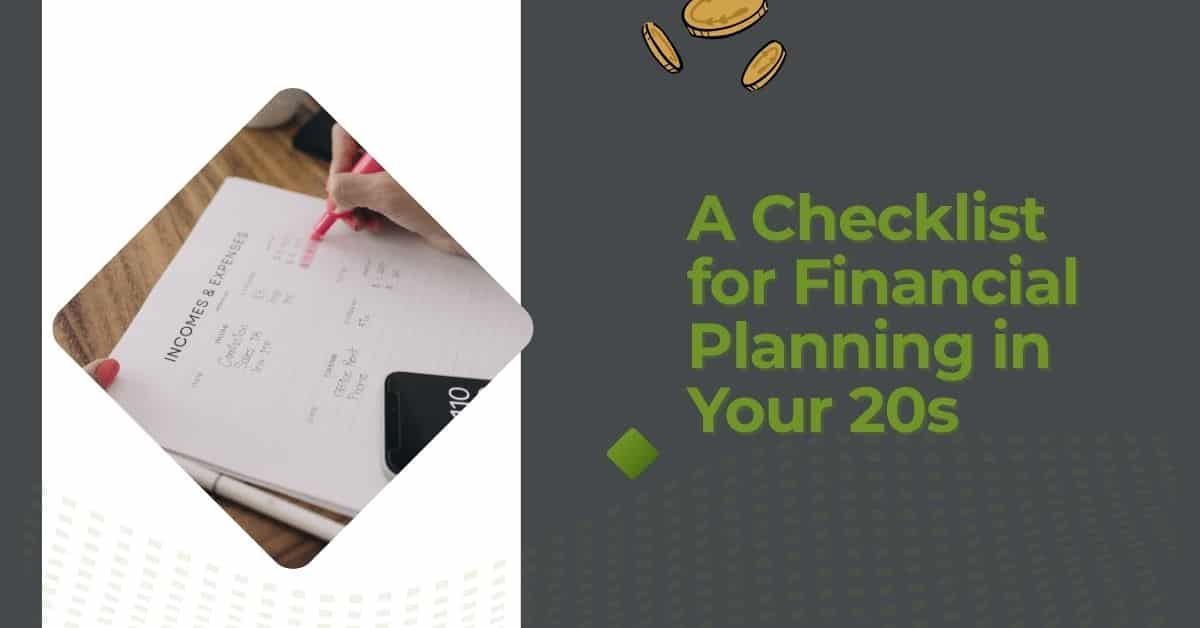Financial Planning Checklist for 20s: In India, the onset of financial independence—your first job, your first pay cheque, and the excitement of handling your own finances—occurs as you enter your 20s. But have you stopped to consider creating a strong financial foundation in the midst of the thrill of becoming an adult? With inflation at a mild 2.07% as of August 2025 and average incomes for young professionals ranging around ₹3–4 lakh annually in 2025, starting wisely can quickly turn modest earnings into your first ₹10 lakh milestone. For Indians in their 20s, this comprehensive guide provides a thorough financial planning checklist that combines investing techniques, real-world insights, and helpful advice to create a wealth-building path. Understanding these procedures in October 2025, when the RBI’s repo rate is a stable 5.5%, will help you manage economic stability and take advantage of growth possibilities, regardless of your level of experience.
Given that India’s GDP is expected to increase by 7-8% in FY 2025–2026, your 20s are the ideal time to start your journey towards long-term success. Let’s take it one step at a time, making sure you have the resources to reach the ₹10 lakh milestone through smart investing, saving, and decision-making.
The Importance of Financial Planning in Your 20s
Time is your greatest ally, therefore your 20s are a great time to plan your finances. You may concentrate on creating habits that last for decades when you have less obligations, such as home or family debts. Starting early can possibly turn small investments into significant riches by retirement by utilising the power of compounding, where your money gets returns on returns, according to financial experts.
Poor planning can result in missed opportunities or debt traps in India, where lifestyle inflation and healthcare expenditures are expected to climb by 15-20% annually. On the other hand, a well-thought-out strategy guarantees financial independence, preparedness for emergencies, and objectives like financing higher education or purchasing a vehicle. According to 2025 trends, young folks who prioritise investments and budgeting see a 20–30% faster creation of wealth.
Important advantages include:
- Establishing credit for upcoming loans.
- Protecting oneself from job insecurity and inflation.
- Reaching milestones such as earning your first ₹10 lakh, which might be used to finance a company or down payment.
Compounding’s Power: Your Secret Weapon
According to reports, Einstein claimed that compounding was the eighth wonder of the universe. Simply put, it’s reinvesting profits to increase returns. By investing ₹5,000 per month at a 12% annual return (normal for stock mutual funds), a 25-year-old might have nearly ₹1 crore by the time they are 60 years old.
Compounding performs even better in 2025, when steady interest rates and moderate inflation of 2.6% are anticipated for the year. Start with mutual fund SIPs; at 15% yields, even ₹1,000 per month might rise to ₹10 lakh in 10–12 years. To visualise, use online calculators; Groww and Zerodha are two simple tools.
A Checklist for Financial Planning in Your 20s
This is a well-organised checklist to get you started. Adjust it based on your risk tolerance and income. The following table lists important actions, deadlines, and implementation advice.

| Step | Description | Timeline | Tips & Tools |
| 1. Asses Your Finances | Track income, expenses, assets, and debts. Calculate net worth (assets minus liabilities) | Immediate (1 – 2 weeks) | Use apps like Money Manager or Excel. Aim for 50/30/20 rule: 50% needs,30% wants, 20% savings |
| 2. Build an Emergency Fund | Save 3-6 months expenses in a liquid account. | 3-6 months | High-yield savings accounts at 4-5% interest. Automate transfers post-payday |
| 3. Manage and Eliminate Debt | Prioritize high-interest debts like credit cards (18-40% APR) | Ongoing | Snowball method: Pay smallest debts first. Avoid new debt; use debit cards |
| 4. Get Insured | Secure health and term life insurance | Within 1 month | Choose for 1 crore term cover (500-1,000/month premium). Use Section 80D for tax benefits |
| 5. Start Investing | Allocate 20% of income to investment. Diversify across stocks, mutual funds, PPF | Start small, scale up | SIP in equity funds for growth; PPF for tax-free returns (7.1% in 2025) |
| 6. Plan for Retirement | Contribute to EPF/NPS | From first job | NPS offers up to 14% returns; tax benefits under 80C |
| 7. Boost Financial Literacy | Educate on taxes, markets | Continuous | Read books like “Rich Dad Poor Dad”; follow podcasts or YouTube channels |
| 8. Set Goals & Review | Aim for 10 lakh; review quarterly | Annually adjust | Use goal trackers; consult certified planners if needed |
This checklist guarantees a balanced approach and was inspired by 2025 financial hacks.
Comprehensive Dissection: Implementing the Checklist into Practice
1. Evaluate and Make a Smart Budget
Begin by recording your monthly expenses. Cut back on wasteful expenses like eating out (target for less than 10% of income), as entry-level incomes typically range from ₹25,000 to ₹30,000 per month. Tools: Auto-tracking Walnut app.
2. Essentials of an Emergency Fund
Invest in liquid funds that yield 6–7% during turbulent periods. Aim for ₹60,000–1,20,000 per month for costs of ₹20,000.
3. Techniques for Debt Management
The average interest rate on credit card debt is 36%; pay it off quickly. Reduce the interest rates on student loan consolidation.
4. Insurance: Your Protective Layer
Health insurance through personal plans or through employers (coverage of ₹10-15 lakh). dependents’ term life insurance.
5. Investment Opportunities for 2025
- Mutual funds and SIPs: Start with ₹500 per month and invest in equity for high returns (12–15%).
- PPF/NPS: Safe and tax-saving (7–8% returns).
- Stocks/ETFs: Blue-chip companies like Reliance offer stocks and ETFs through demat accounts.
- FDs and gold: FDs at 6-7% post-repo stability for stability.
Diversify by having 30% debt, 60% equity, and 10% other assets.
6. Tax and Retirement Planning
For further 80CCD benefits, use ELSS, PPF, and NPS with a maximum 80C limit of ₹1.5 lakh.
7. Ongoing Education
Join Reddit forums such as r/personalfinanceindia.
A Guide to Your First Ten lakh rupees
Assuming a monthly salary of ₹30,000, invest or save ₹6,000 (20%). Reach ₹10 lakh using SIPs in about 8 years at 12% yields. Use bonuses or side work to speed up.
For example: Mumbai resident Raj, 24, saved ₹5,000 a month in mutual funds. He funded his MBA with ₹12 lakh by the age of thirty.
Common Mistakes to Avoid in Your 20s
- Lifestyle creep: Avoid using raises to increase spending.
- Ignoring insurance: Savings can be lost due to medical crises.
- Excessively making unresearched investments in fads like cryptocurrency.
- Lack of diversification puts all your eggs in one basket at risk of losing money.
Frequently Asked Questions (FAQs)
In my twenties, how should I begin financial planning?
Start by creating an emergency fund and creating a budget. Keep tabs on spending and save aside 20% of your salary.
In order to reach ₹10 lakh, how much should I invest each month?
Depending on compounding, ₹5,000–10,000 at 12–15% rates can bring you there in 7–10 years.
In 2025, are mutual funds secure for new investors?
Yes, particularly in the case of diversified stock funds. For rupee-cost averaging, start with SIPs.
Should I put more emphasis on investing or paying off debt?
Invest after taking on high-interest debt. Use the debt-snowball method to stay motivated.
Which tax advantages are open to young investors?
Section 80D for health insurance, and Section 80C for PPF/ELSS (₹1.5 lakh).
What impact will inflation have on my 2025 savings?
Invest in assets that outperform inflation, such as stocks, as it reduces buying power at a rate of 2.07%.
For retirement, is NPS preferable to EPF?
For improved results, NPS provides greater equity exposure and flexibility.
Conclusion
Planting seeds for a successful future is what your twenties are all about. You can construct your first ₹10 lakh and more with confidence if you follow this checklist in the midst of 2025’s stable economy, which includes low inflation and steady rates. Maintain discipline, evaluate your progress every three months, and adjust as necessary. Consistency is more important than perfection. Get started now and see your wealth increase!
How to Build an Emergency Fund on a Low Salary – A Step Towards Stress-Free Living
Daily Money Saving Hacks for Indian Millennials: Freedom Starts Small
Top 7 Digital Finance Tools to Simplify Budgeting for Beginners!

I’m Rashid Ali, a personal finance blogger and content creator at SavingSecret.in, helping young adults in India master saving, investing, and tax planning. I simplify money topics like budgeting, IPO updates, and stock market tips to make finance easy and actionable. Follow me for smart money moves that actually work!
